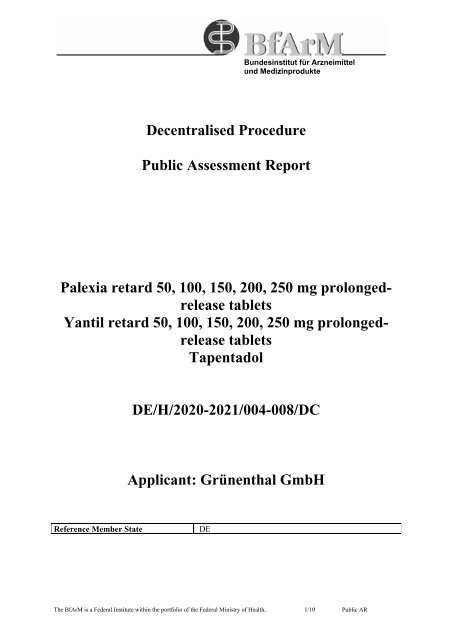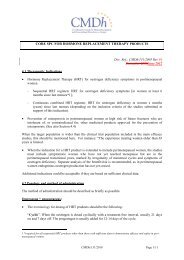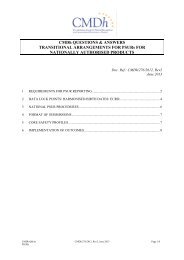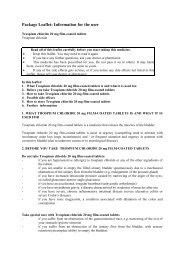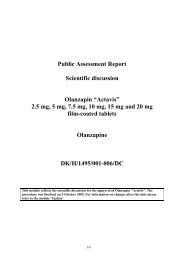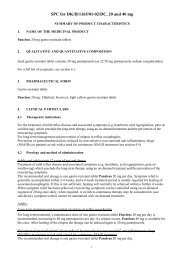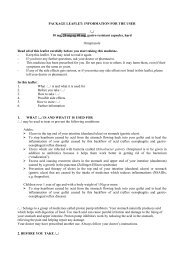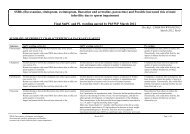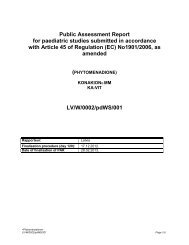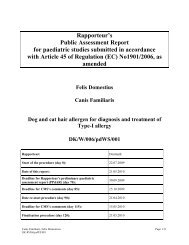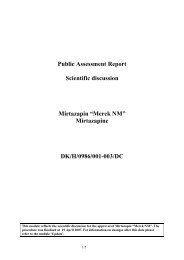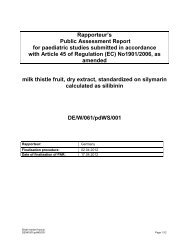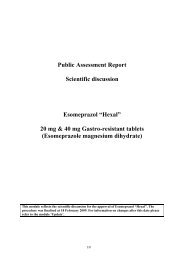release tablets Yantil retard 50, 100, 150, 200, 250 mg prolonged
release tablets Yantil retard 50, 100, 150, 200, 250 mg prolonged
release tablets Yantil retard 50, 100, 150, 200, 250 mg prolonged
You also want an ePaper? Increase the reach of your titles
YUMPU automatically turns print PDFs into web optimized ePapers that Google loves.
Bundesinstitut für Arzneimittel<br />
und Medizinprodukte<br />
Decentralised Procedure<br />
Public Assessment Report<br />
Palexia <strong>retard</strong> <strong>50</strong>, <strong>100</strong>, 1<strong>50</strong>, <strong>200</strong>, 2<strong>50</strong> <strong>mg</strong> <strong>prolonged</strong><strong>release</strong><br />
<strong>tablets</strong><br />
<strong>Yantil</strong> <strong>retard</strong> <strong>50</strong>, <strong>100</strong>, 1<strong>50</strong>, <strong>200</strong>, 2<strong>50</strong> <strong>mg</strong> <strong>prolonged</strong><strong>release</strong><br />
<strong>tablets</strong><br />
Tapentadol<br />
DE/H/2020-2021/004-008/DC<br />
Applicant: Grünenthal GmbH<br />
Reference Member State DE<br />
The BfArM is a Federal Institute within the portfolio of the Federal Ministry of Health. 1/10 Public AR
TABLE OF CONTENTS<br />
I. INTRODUCTION......................................................................................................................... 4<br />
II. EXECUTIVE SUMMARY....................................................................................................... 4<br />
II.1 Problem statement..................................................................................................................... 4<br />
II.2 About the product ..................................................................................................................... 4<br />
II.3 General comments on the submitted dossier .......................................................................... 4<br />
II.4 General comments on compliance with GMP, GLP, GCP and agreed ethical principles..4<br />
III. SCIENTIFIC OVERVIEW AND DISCUSSION ................................................................... 5<br />
III.1 Quality aspects....................................................................................................................... 5<br />
III.2 Nonclinical aspects ................................................................................................................ 6<br />
III.3 Clinical aspects ...................................................................................................................... 6<br />
IV. BENEFIT RISK ASSESSMENT ........................................................................................... 10<br />
2/10 Public AR
Proposed name of the medicinal<br />
product in the RMS<br />
INN (or common name) of the active<br />
substance(s):<br />
Pharmaco-therapeutic group<br />
(ATC Code):<br />
Pharmaceutical form(s) and<br />
strength(s):<br />
Reference Number for the<br />
Decentralised Procedure<br />
ADMINISTRATIVE INFORMATION<br />
Palexia <strong>retard</strong> <strong>50</strong>, <strong>100</strong>, 1<strong>50</strong>, <strong>200</strong>, 2<strong>50</strong> <strong>mg</strong> Retardtabletten<br />
<strong>Yantil</strong> <strong>retard</strong> <strong>50</strong>, <strong>100</strong>, 1<strong>50</strong>, <strong>200</strong>, 2<strong>50</strong> <strong>mg</strong> Retardtabletten<br />
Tapentadol<br />
N 02 AX 06<br />
<strong>50</strong>, <strong>100</strong>, 1<strong>50</strong>, <strong>200</strong>, 2<strong>50</strong> <strong>mg</strong> <strong>prolonged</strong>-<strong>release</strong> <strong>tablets</strong><br />
DE/H/2020-2021/004-008/DC<br />
Reference Member State: DE<br />
Member States concerned: BE, BG, CY, CZ, DK, EE, EL, ES, FI, HU, IE, IS, IT, LT,<br />
LU, LV, MT, NO, PL, PT, RO, SE, SI, SK, UK<br />
Applicant (name and address) Grünenthal GmbH<br />
Zieglerstraße 6<br />
D-52078 Aachen<br />
Farmaceutici Formenti S.p.A.<br />
Names and addresses of<br />
Via Vittor Pisani 16,<br />
manufacturers responsible for batch<br />
20124 Milano, Italy<br />
<strong>release</strong> in the EEA<br />
alternatively<br />
Grünenthal GmbH<br />
Zieglerstr. 6<br />
52078 Aachen, Germany<br />
3/10 Public AR
I. INTRODUCTION<br />
Based on the review of the data on quality, safety and efficacy, the application for Palexia/<strong>Yantil</strong> <strong>50</strong>,<br />
<strong>100</strong>, 1<strong>50</strong>, <strong>200</strong>, 2<strong>50</strong> <strong>mg</strong> <strong>prolonged</strong>-<strong>release</strong> <strong>tablets</strong>, in the treatment of severe chronic pain requiring<br />
opioid therapy is approved.<br />
II. EXECUTIVE SUMMARY<br />
II.1 Problem statement<br />
Tapentadol is a new chemical entity developed for the treatment of moderate to severe pain of<br />
different non-malignant and malignant origin. Currently, a variety of different analgesic substances are<br />
on the market. Pharmacologically severe pain is mainly treated by opioids, but depending on the origin<br />
of pain and its characteristics, also NSAIDS and other substances play an important role.<br />
II.2 About the product<br />
Tapentadol is a centrally active analgesic agent which acts as a µ-receptor agonist and an inhibitor of<br />
norepinephrine reuptake. (Please refer to the Public Assessment Report of the IR formulation<br />
(DE/H/2020/001-004/DC). The Anatomical Therapeutic Chemical (ATC) classification code is N02<br />
AX 06. The claimed indication is “Tapentadol is indicated for the management of severe chronic pain<br />
in adults, which can be adequately managed only with opioid analgesics.” The film coated <strong>prolonged</strong><br />
<strong>release</strong> <strong>tablets</strong> should be taken twice daily, approximately every 12 hours up to a maximal daily dose<br />
of <strong>50</strong>0 <strong>mg</strong>. The treatment should be started with single doses of <strong>50</strong> <strong>mg</strong> b.i.d. and up-titrated every<br />
three days in increments of <strong>50</strong> <strong>mg</strong> b.i.d. up to an optimal dose.<br />
II.3 General comments on the submitted dossier<br />
This application is submitted as a decentralised procedure according to Article 28(3) of Directive<br />
<strong>200</strong>1/83/EC with Germany as Reference Member State. AT, BE, BG, CY, CZ, DK, EE, EL, ES, FI,<br />
FR, HU, IE, IS, IT, LT, LU, LV, MT, NL, NO, PL, PT, RO, SE, SI, SK and UK were involved as<br />
Concerned Member States. The applicant, however, withdrew in AT, FR and NL.<br />
The application concerns a new active substance, tapentadol hydrochloride manufactured as a slow<br />
<strong>release</strong> formulation, submitted under the tradename Palexia SR, which is not yet authorised by any of<br />
the European Member States. A duplicate application under the product name Ixarto SR and the<br />
application for the immediate <strong>release</strong> formulation have simultaneously been submitted. The immediate<br />
<strong>release</strong> formulation Tapentadol IR was approved by the US Food and Drug Administration on 20 th<br />
November <strong>200</strong>8 for the relief of moderate to severe acute pain in adults.<br />
Consideration of this application is also requested under the Article 10(1) of Directive <strong>200</strong>1/83/EC /<br />
Article 14(11) of Regulation (EC) No 726/<strong>200</strong>4 (one year of market exclusivity for a new indication).<br />
According to Article 7 of the Paediatric Regulation this application includes a PIP (Decision Number<br />
P/48/<strong>200</strong>9). Development in other special populations has not been performed.<br />
A risk management plan has been provided.<br />
This medicinal product has been given formal scientific advice by the CHMP<br />
(EMEA/CPMP/SAWG/845/04, procedure No EMEA/H/SA/371/2/<strong>200</strong>3/II and EMEA/CPMP/SAWP/<br />
363827/06, procedure No EMEA/H/SA/371/2/FU/1/<strong>200</strong>6/II). Member States UK (<strong>200</strong>1-11-19), FR<br />
(<strong>200</strong>2-01-09), DE (<strong>200</strong>2-01-15) and SE (<strong>200</strong>5-10-17) have also given scientific advice. In addition,<br />
pre-submission meetings were conducted with CZ, NL, DE, UK, SE, IT, FR and ES.<br />
II.4 General comments on compliance with GMP, GLP, GCP and agreed ethical<br />
principles.<br />
The RMS has been assured that acceptable standards of GMP are in place for these product types at all<br />
4/10 Public AR
sites responsible for the manufacture and assembly of this product. For manufacturing sites within the<br />
Community, the RMS has accepted copies of current manufacturer authorisations issued by inspection<br />
services of the competent authorities as certification that acceptable standards of GMP are in place at<br />
those sites.<br />
For all studies presented within this AR, the applicant declares that the study was conducted in<br />
accordance with the ethical principles that have their origin in the Declaration of Helsinki and that are<br />
consistent with Good Clinical Practices and applicable regulatory requirements.<br />
GCP inspections have been conducted in single sites involved in the phase III study KF5<strong>50</strong>3/35 in<br />
patients with post-operative pain after hysterectomy. Subsequent to GCP findings some of the<br />
participating sites were excluded from the dataset. At Day 106 the Applicant provided an Addendum<br />
to the clinical trial report of study KF5<strong>50</strong>3/35 based on the reduced dataset. The data that were<br />
presented in this Addendum are considered valid.<br />
Relevant toxicological investigations were conducted in compliance with GLP standards. However,<br />
not all safety pharmacology studies are conforming to GLP regulations, because they were performed<br />
before ICH S7A and S7B came into force. Nonetheless, these studies are satisfactorily documented.<br />
III. SCIENTIFIC OVERVIEW AND DISCUSSION<br />
III.1 Quality aspects<br />
Drug substance<br />
Tapentadol hydrochloride is a new chemical entity, not described in any pharmacopoeia. The content<br />
of this ASMF follows the requirements of the note for guidance “Chemistry of New Active<br />
Substance” (CPMP/QWP/130/96 Rev1). Letter of access has been provided.<br />
Tapentadol hydrochloride drug substance is manufactured through a series of organic synthesis steps<br />
starting from commercially available chemicals.<br />
No major concerns raised during the assessment of the documentation regarding the ASMF provided.<br />
The questions regarding the open part and restricted part have been sufficiently answered. The re-test<br />
period of 36 months is accepted.<br />
Drug Product<br />
Tapentadol <strong>prolonged</strong> <strong>release</strong>d <strong>tablets</strong> are film-coated, oblong shaped <strong>tablets</strong>. The conversion factor<br />
from tapentadol free base to its hydrochloride salt is 1.1648 and reverse 0.8585.<br />
The tablet cores of the different dosage strengths have the same qualitative excipient composition but<br />
they vary in quantity, drug substance concentration, tablet core weight and diameter. The excipients<br />
used for the tablet core, hypromellose <strong>100</strong>,000 mPas, cellulose microcrystalline, colloidal anhydrous<br />
silica, magnesium stearate and purified water are well known pharmaceutical ingredients and their<br />
quality is described in Ph. Eur. monographs.<br />
The dosage strength can be differentiated by using different colours for the film coating material.<br />
The description of the product development and its proof of concept are comprehensible and supported<br />
by dissolution data.<br />
The ingredients and the manufacturing process of the <strong>prolonged</strong> <strong>release</strong> tablet, comprising standard<br />
blending, compression, film coating processes, are considered suitable to produce a pharmaceutical<br />
product of the proposed quality.<br />
Sufficient process validation data is available, proving a robust and reproducible process.<br />
All relevant quality characteristics of the drug product (<strong>release</strong> and shelf-life) are specified. The<br />
proposed limits are justified. The description of the analytical methods used to analyse the drug<br />
substance and drug product are adequate, the validation results are plausible. The stability data<br />
5/10 Public AR
ecently available justifies a shelf-life of 36 months without label claim for the package proposed for<br />
marketing.<br />
III.2 Nonclinical aspects<br />
The pharmacological and toxicological characteristics of tapentadol as evaluated in non-clinical<br />
investigations are extensively described in the assessment report as well as in the Public Assessment<br />
Report of the IR formulation (DE/H/2020/001-004/DC).<br />
III.3 Clinical aspects<br />
Pharmacokinetics<br />
The initial development of tapentadol for clinical use was performed with an immediate <strong>release</strong><br />
formulation. For details please refer to the Preliminary Assessment of the dossier of the IR<br />
formulation. Due to the relatively short half life of tapentadol (4-5 h) a <strong>prolonged</strong>-<strong>release</strong> formulation<br />
was developed for the treatment of chronic pain.<br />
Tapentadol PR <strong>tablets</strong> of 2 sizes are intended to be commercialized. For the lower dose strengths of <strong>50</strong><br />
<strong>mg</strong>, <strong>100</strong> <strong>mg</strong> and 1<strong>50</strong> <strong>mg</strong> of tapentadol, a smaller tablet (designated PR2small) was developed to offer<br />
a more convenient and easy to swallow tablet to the patient. The PR2 formulation was designed for the<br />
upper dose strengths of <strong>200</strong> <strong>mg</strong> and 2<strong>50</strong> <strong>mg</strong> of tapentadol. The tablet cores of the different dose<br />
strengths have an identical qualitative excipient composition but vary in their quantitative<br />
composition, drug substance amount, tablet core weight and tablet size. Initial studies used an early<br />
tapentadol PR formulation, referred to as PR1. Phase 3 studies have been performed with the PR 2<br />
formulation, the equivalence of PR2small was assessed by comparative in-vitro dissolution testing at<br />
all strengths and by bioequivalence studies for the <strong>50</strong> and 1<strong>50</strong> <strong>mg</strong> strengths.<br />
The following table gives an overview of the key studies contributing to the biopharmaceutical<br />
characterization of tepentadol PR:<br />
Furthermore, pharmacokinetic data has been explored during the clinical efficacy studies (see below).<br />
The pharmacokinetic study program is adequate. The applicant conducted studies with an early<br />
formulation PR1 to explore bioavailability and food effect. Dose proportionality and food effect was<br />
also explored with the PR2 formulation. Furthermore, studies to demonstrate bioequivalence of the to<br />
be marketed PR2small formulation with the PR2 formulation, have been conducted.<br />
The applicant demonstrated bioavailability comparable to the IR formulation. A slight food effect<br />
could be shown, which is regarded not clinically relevant. Dose proportionality is assumed for doses<br />
up to <strong>200</strong> <strong>mg</strong> tapentadol PR. Bioequivalence could be demonstrated between formulations.<br />
6/10 Public AR
Pharmacodynamics<br />
Please refer to the Assessment of the IR formulation.<br />
It is not expected, that the pharmacodynamic profile differs from that of the IR formulation.<br />
Clinical efficacy<br />
The study programme consisted of Phase 2 and Phase 3 studies in adult subjects with chronic pain of<br />
different etiologies (osteoarthritis, chronic low back pain and diabetic peripheral neuropathy) outlined<br />
in the following table:<br />
Tramadol SR (<strong>200</strong>-400 <strong>mg</strong> daily) and Oxycodone CR (20-40 <strong>mg</strong>) have been chosen as active<br />
comparators during the phase IIb studies as they are well established to be effective and safe in the<br />
treatment of moderate to severe pain conditions. Nevertheless, in the above described Phase IIb<br />
studies, efficacy of these active comparators could not be confirmed.<br />
No conclusions can be drawn from three of four Phase II dose finding studies, as neither the active<br />
comparator nor the tested doses of tapentadol SR showed significant analgesic efficacy compared to<br />
7/10 Public AR
placebo. Only KF5<strong>50</strong>3/19 could show efficacy of tapentadol SR in the range 1<strong>50</strong> to <strong>200</strong> <strong>mg</strong> b.i.d.<br />
However, the CHMP (EMEA/CHMP/SAWP/363827/<strong>200</strong>6) had no major objection to the dose range<br />
chosen (see below) for use in the Phase 3 studies based on the above dose finding studies.<br />
Four main Phase III studies have been conducted, three of them in a nearly identical design, using<br />
oxycodone CR as the active comparator. Efficacy of tapentadol PR (<strong>100</strong> <strong>mg</strong> to 2<strong>50</strong> <strong>mg</strong> twice daily) for<br />
the treatment of moderate to severe chronic pain was studied in 3 pain conditions (chronic<br />
osteoarthritis, chronic low back pain, and painful diabetic peripheral neuropathy). The majority of<br />
subjects (≥ 80%) had severe pain at baseline. Statistical separation from placebo for the primary<br />
efficacy endpoints was demonstrated in 2 of these 3 similar designed studies for a period of up to 12<br />
weeks. The results of the third study showed effects of tapentadol PR that were in the same direction<br />
as the other studies not reaching statistical significance. Furthermore an additional study in patients<br />
with DPN has been performed in a withdrawal design. In total of 3260 patients have been included in<br />
the main studies of whom 1174 were exposed to the study drug.<br />
The design of the submitted studies has been discussed prior by the CHMP during a scientific advice<br />
(EMEA/CPMP/SAWP/845/04 and EMEA/CHMP/SAWP/363827/<strong>200</strong>6): It was pointed out by the<br />
CHMP that in Europe OA and LBP are not primarily treated with opioids but with NSAIDs, COX-2<br />
inhibitors and non-pharmacological measures. OA and LBP are recommended as models for mild to<br />
moderate pain conditions. Choosing these pain models, it is required to assure that a representative<br />
number of patients is suffering from severe pain (NRS ≥6) and is not responding to first line<br />
analgesics after a trial period of sufficient duration. This has been fulfilled.<br />
The objections regarding study designs, conduct and results of the studies could be resolved and in<br />
conclusion across studies clinical efficacy in the treatment of severe chronic pain can be regarded as<br />
demonstrated.<br />
Clinical safety<br />
The applicant provided comprehensive safety documentation. Safety assessment has been performed<br />
for every single clinical study. Additionally a pooled safety analysis has been presented in the clinical<br />
safety summary and in a smaller proportion in the clinical overview.<br />
3,420 patients received tapentadol within the placebo-controlled study program. 494 received<br />
tapentadol for more than 6 month and 243 patients for more than 12 month. This fulfils the<br />
requirements of ICH E1 and is acceptable.<br />
The most commonly reported adverse events within the clinical studies were typical opioid induced<br />
side effects like nausea, dizziness, constipation, headache, somnolence, and vomiting. The majority of<br />
all reported TEAEs was mild to moderate in intensity. The incidence of respiratory depression, another<br />
typical opioid induced side effect was very low (< 0.1%) in the tapentadol group. The side effect<br />
profile was comparable to that of oxycodone but with lower frequency and intensity. The only<br />
common TEAE that occurs as often in the tapentadol group as in the oxycodone group was headache.<br />
The norepinephrine uptake inhibiting effect seems to cause no additional side effects not known as<br />
typical opioid side effects. Deaths occurred primarily in subjects with progression of neoplasm and<br />
were not related to the study drug.<br />
The side effect profile of tapentadol is comparable to the side effect profile strong opioids. Incidence<br />
of TEAEs increases with increasing doses. Typical withdrawal symptoms occur in some subjects<br />
following abrupt cessation of treatment. Tapentadol should be classified as a substance with a relevant<br />
drug abuse potential.<br />
Pharmacovigilance system<br />
The applicant has provided documents that set out a detailed description of the system of<br />
pharmacovigilance (Version 3.0 dated 15 April 2010). A statement signed by the applicant and the<br />
qualified person for pharmacovigilance, indicating that the applicant has the services of a qualified<br />
person responsible for pharmacovigilance and the necessary means for the notification of any adverse<br />
reaction occurring either in the Community or in a third country has been provided.<br />
8/10 Public AR
The Pharmacovigilance system as described by the applicant fulfils the requirements as described in<br />
Volume 9A of the Rules Governing Medicinal Products in the European Union and provides adequate<br />
evidence that the applicant has the services of a qualified person responsible for pharmacovigilance<br />
and has the necessary means for the notification of any adverse reaction suspected of occurring either<br />
in the Community or in a third country.<br />
Risk Management Plan<br />
Safety specification:<br />
The following non-clinical safety concerns have been investigated: QT-prolongation, potential for<br />
abuse, convulsion, reproductive toxicity. Convulsions and reproductive toxicity will be accounted for<br />
in the SPC.<br />
No risk of QT-prolongation was observed. Potential for abuse is acknowledged and regarded as<br />
comparable to other opioids. Convulsions and reproductive toxicity will be accounted for in the SPC.<br />
A list of adverse reactions grouped by frequency and SOC observed in clinical trials is presented for<br />
both the immediate and the <strong>prolonged</strong> <strong>release</strong> formulation. Populations not studied or with limited data<br />
include mainly patients below the age of 18, pregnant and lactating women, patients with severe renal<br />
impairment, patients with clinically relevant hepatic impairment (Transaminases > 3 times ULN),<br />
patients on MAO inhibitors and patients with a history of drug or alcohol abuse. These aspects will be<br />
reflected in the relevant sections of the SPC.<br />
As the product has not been launched prior to the finalization of this version of the RMP, no data on<br />
post-authorization usage is available.<br />
No clinically relevant interactions were observed in the drug-drug interaction studies. Additive CNS<br />
depression is expected with other CNS depressants. Both will be stated in the SPC.<br />
Pharmacological class effects of the group of µ-opioid receptor agonists include potential for abuse,<br />
convulsion, respiratory depression and bowel hypomobility. Compared to other opiods the risk of<br />
respiratory depression and bowel hypomobilty is regarded as low.<br />
A summary tabulation of ongoing safety concerns can be found below:<br />
Important identified risks Drug abuse and drug dependence<br />
Convulsion<br />
Important potential risks, Overdose<br />
Off-label use in pediatric patients<br />
Potential for medication errors<br />
Accidental exposure<br />
Diversion<br />
Important missing information Use in pediatrics<br />
Following the initial assessment the MAH agreed to replace the originally suggested important<br />
identified risk “Potential for abuse” by the more exact wording “Drug abuse and drug dependence”.<br />
Pharmacovigilance Plan:<br />
Apart from routine pharmacovigilance practices no additional pharmacovigilance activities have been<br />
suggested by the applicant. No additional studies are considered necessary by the applicant.<br />
Risk minimization plan:<br />
Apart from routine risk minimization activities (labeling, controlled drug status, inclusion into CCDS)<br />
no additional risk minimization activities have been proposed for the identified safety concerns. Thus<br />
no risk minimization plan is presented.<br />
Summary of the risk management plan<br />
Safety concern Proposed pharmacovigilance<br />
activities (routine and<br />
Proposed risk minimization<br />
activities (routine and<br />
9/10 Public AR
Drug abuse and drug<br />
dependence<br />
Overdose<br />
Diversion<br />
additional) additional)<br />
Routine Pharmacovigilance<br />
practices are considered to be<br />
sufficient.<br />
Convulsion Routine Pharmacovigilance<br />
practices are considered to be<br />
sufficient.<br />
Potential for medication errors<br />
Accidental exposure<br />
Use in pediatrics<br />
Off-label use in pediatric patients<br />
Routine Pharmacovigilance<br />
practices are considered to be<br />
sufficient.<br />
Routine Pharmacovigilance<br />
practices are considered to be<br />
sufficient.<br />
IV. BENEFIT RISK ASSESSMENT<br />
The benefit risk assessment is positive.<br />
The application is approved.<br />
10/10 Public AR<br />
Appropriate labeling (Warning<br />
in section 4.4 and description in<br />
4.9of the CCDS) and the use of<br />
legal status of the drug as a<br />
controlled drug. No further risk<br />
minimization activities are<br />
identified as necessary or<br />
requested to date.<br />
Appropriate labeling (Warning<br />
in section 4.4 of the CCDS). No<br />
further risk-minimization<br />
activities, other than labeling<br />
has been conducted to date. No<br />
further risk-minimization<br />
activities are identified as<br />
necessary or requested to date.<br />
Appropriate labeling. No<br />
further risk-minimization<br />
activities, other than labeling<br />
has been conducted to date. No<br />
further riskminimization<br />
activities are identified as<br />
necessary or requested to date<br />
Appropriate labeling. No<br />
further risk-minimization<br />
activities, other than labeling<br />
has been conducted to date. No<br />
further riskminimization<br />
activities are identified as<br />
necessary or requested to date.<br />
A development program to<br />
address the pediatric population<br />
is defined in the agreed PIP.


